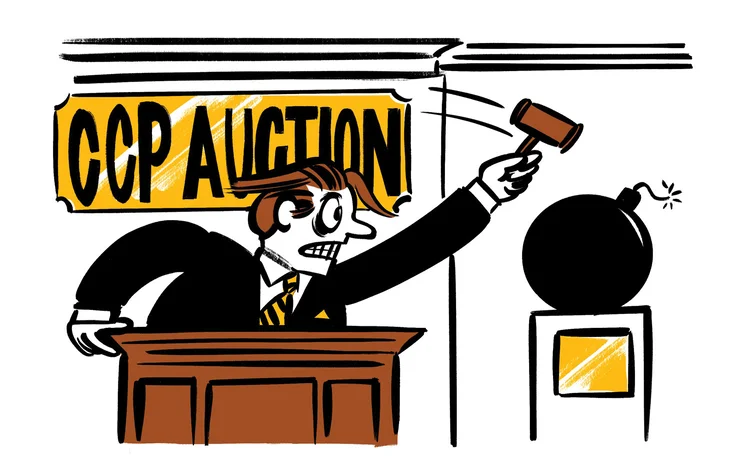
Hammer horror: banks fear CCP auctions after Nasdaq
Auction failure at Nasdaq sparks debate over who gets to bid on portfolios, and whether they should be pre-hedged

Need to know
- The default of power trader Einar Aas has focused market participants’ attention on the failure of the subsequent auction at Nasdaq Clearing, which is fingered as having crystallised a €107 million loss for members.
- Many argue broad auction participation is key to minimising the risk of mutualised losses, and that pre-auction hedging should be used to flatten the risk of concentrated or directional portfolios.
- Nasdaq is understood to have decided against hedging Aas’s portfolio before the first, unsuccessful auction, amid concerns over stepping into a gapping, illiquid market.
- The CCP is understood to have executed some risk-reducing transactions ahead of the second auction, which was successful – but possibly at the cost of locking in a loss for clearing members.
- Some counter that inviting a small cadre of specialists to bid on naked risk in a snap auction can sometimes yield a better price for members, minimising or avoiding mutualised losses.
When a garden-variety default at Nasdaq Clearing turned into a nine-figure loss, it focused industry minds on the arcane mechanics of CCP default auctions – an important process that is often drowned out by more high-profile rows between central counterparties (CCPs) and their members.
“[This event] brings everyone’s processes and procedures back into focus,” says a CCP expert who took part in the default auction at a large clearing house for certain of Lehman Brothers' assets after the bank's failure. “Hitting the default fund is a major event, and I think it’s going to double down regulators’ focus on [auction] risk management at CCPs.”
Following the default of power trader Einar Aas on the Nasdaq Commodities market last September, several parts of the default management process have been called into question by the CCP’s members, who say they strongly suspect the failure of the first auction Nasdaq ran – which they believe was mismanaged by the CCP and its default management committee (DMG) – was what crystallised the €107 million ($121.1 million) mutualised portion of the loss they were required to mop up.
Principal among the issues are whether – and how – a defaulter’s portfolio should be hedged before an auction, and who should be invited to bid on it. Nasdaq has been accused by members of poor decision-making on both counts.
Following Aas's default, Nasdaq held two auctions in a bid to return itself to a matched book. The first unsuccessful auction took place on the morning of Tuesday, September 11. The second took place on the evening of Wednesday, September 12, when the portfolio was eventually closed out with cumulative losses of €114 million for the CCP and its members.
Risk.net understands the CCP decided not to execute hedges before the first, failed auction, for fear of moving the market when executing hedging transactions in an illiquid product segment – but that it opted to execute some risk-reducing transactions before the second auction, which was successful. It is not clear what resulted in bids that the CCP deemed sufficient to close out the portfolio in the second auction, but the hedges placed may have played a role. Nasdaq declined to comment.
Whether to apply a reserve price to a defaulter’s portfolio – which market participants believe Nasdaq did for the first, abortive auction – was also a vexed question among the CCP risk managers speaking to Risk.net for this article, as was the composition of a clearer’s DMG. Other issues include means of disincentivising bad bidding and how to reduce information leakage from auctions.
Global regulators have also pinpointed auction risk as a critical point of failure in the default management process in the wake of the incident. Two supranational bodies – the International Organization of Securities Commissions and the Committee on Payments and Market Infrastructures – are working on a joint discussion paper on the subject, which is slated to address issues including the process for dealing with a failed auction; how to communicate auction outcomes; and grounds for collaboration between CCPs when there are multiple auctions taking place.
A bitter pill
The mutualised losses were a bitter pill for the bourse’s 166 members – at least one has said it plans to leave the CCP in the wake of the incident – but one that was ultimately swallowable. What if the auction failure had occurred on the large complex portfolios of a major futures commission merchant (FCM), who was a sizeable member of all the world’s major derivatives clearing houses?
How regulators react remains to be seen – but one thing CCPs and members are agreed on is the need for CCPs to retain flexibility to tailor their default management processes to the circumstances of each incident. During a default, CCPs must carefully manage the processes in a manner that prevents the need for inflicting mutualised losses on members.
In this regard, Nasdaq is accused of getting the balance wrong. Its decision to invite only four clearing members to the auction was widely criticised by many CCP experts speaking to Risk.net. Most CCPs go out of their way to involve as many members as possible in an auction: Eurex, for example, makes participation mandatory for clearing members that trade or clear the products listed in the segment of a portfolio that’s being auctioned, provided they are deemed able to take part from a “risk [and] operational perspective”. Clients may also participate voluntarily (see table A). Ice Clear Europe has similar rules.
Nasdaq has defended its selection criteria, arguing it only invited firms it thought able to take on Aas’s portfolio of concentrated spread trades. The four utility companies that took part – Uniper, Statkraft, Fortum and Vattenfall, with the last-named understood to have won Aas’s portfolio – were chosen by Nasdaq because they were deemed to be major market players most likely to have the ability and risk appetite to take a position in the products held by Einar Aas, the CCP has said.
Among OTC clearers, LCH’s SwapClear makes it a condition of membership that firms are able to “import, value, and participate in auctions for a defaulted portfolio”, with would-be members forced to pass a fire drill before gaining entry.
“Rather than make the auction about inviting specific firms, it should be set up so that everyone can take part, other than those who can’t based on size or ability,” says Jo Burnham, product manager at margin analytics firm OpenGamma. “If that’s going to be too much of an issue, then you split up the portfolio before you auction it, so people can bid effectively.”
Race to the bottom
Limiting participation to only a few clearing members is contentious for two main reasons. Principally, argue CCPs, it has the potential to dramatically lower the price at which a portfolio sells: less competition means lower bids, the logic goes, whereas inviting more seems to increase the likelihood of getting the defaulted portfolio into the hands of a firm that wants it.
Limiting the number of participants is also decried for a separate reason: fairness. If a clearing member is on the hook to cover spillover losses when a member defaults, there is a decent argument they should have the right to see the portfolio and bid. By deciding to exclude certain clearing members, the CCP takes the ability to mitigate losses from a defaulter out of their hands – essentially deciding how losses are allocated.
At least one of Nasdaq’s members has argued vociferously its firm should have been invited, as a major contributor to the default fund, and therefore one of those required to do the most mopping-up of losses when it failed.
As one risk manager at a European CCP puts it, if a default looks likely to result in a large, mutualised loss, “you really want to make sure everyone who is losing money should have the chance to stand up and do something about it”.
[If a default looks likely to result in a large, mutualised loss,] you really want to make sure everyone who is losing money should have the chance to stand up and do something about it
Risk manager at a European CCP
The opposite is also true, experts point out: in an uncompetitive auction – as appeared to be the case at Nasdaq – the winning bidder can make a windfall gain at the expense of fellow clearing members that were not invited.
A European power trader at one of the four firms invited to the auction tells Risk.net his firm was keen to participate because it had heard Aas’s portfolio had “money in it”.
His firm didn’t win, he adds – but he suspects the company that did win “probably hedged it adequately quickly and made a fortune, if you ask me”.
One clearing executive at another large European CCP comes to the defence of Nasdaq on this point, however. He argues that, if Nasdaq had not ultimately sold off the portfolio at a loss large enough to breach its default fund, few would have complained about the number of firms it had invited to participate.
“If you are liquidating at [what you think is] a fair price, having only gone to one counterparty, that would be pretty extreme. But if you got the right result, you would have performed respectably. If you got a poor result, there will always be plenty of criticism after,” he tells Risk.net. “I guess the Nasdaq guys were balancing tidiness, and getting this done quickly with the number of people participating as well.”
Wider field
One obvious way of broadening the pool of ready players, argue rival CCPs, would have been to extend the invitation to clients of members that are themselves large trading firms. Other CCPs, notably CME Group, routinely invite such firms to participate in default auctions for futures and options portfolios.
Often, trading firms are less constrained by regulatory capital considerations when bidding than banks clearing for large numbers of clients, one observer points out.
“The problem with [only having] clearing members bidding in an auction is that many of them are banks, who are constrained by the leverage ratio. If you are not a bank and you’re a pension fund, or a prop trading company or a sovereign wealth fund, you don’t give a damn about the leverage ratio, you have a lot of dry powder ticking around,” he says.
But increasing audience participation raises another issue: information leakage. What if those trading firms you invited to bid are just out for a fast buck? Whereas clearing members can have their default fund contributions juniorised if they submit lowball bids, why would a hedge fund pass up a chance to look at someone else’s trading positions, even if they had no intention of bidding on them appropriately?
Increasing audience participation raises another issue: information leakage. What if those trading firms you invited to bid are just out for a fast buck?
Indeed, in response to questions as to why so few participants were invited, Nasdaq has previously cited a risk of information leakage.
Concern over participants abusing the information they gain at auction – trading on it themselves or leaking it to others, potentially moving the market further against the positions the CCP is holding – is always a consideration, say firms. But it’s also one they are required to counter by existing CPMI-Iosco guidance on bidding incentives at auction.
Eurex, for instance, applies levies against firms seen as not bidding appropriately during default auctions. Over-the-counter clearer Ice Clear Credit, meanwhile, recently moved to allow non-clearers into the auction process for credit default swap portfolios – but the price of entry is a $10 million contribution to the default fund, which they only get back if their bids are competitive.
Underlying the logic that auctions should maximise the amount of participants they can invite, however, is the ability of the CCP to negate the effects of market movements. As in the case of Einar Aas at Nasdaq, portfolios composed of non-linear positions – or, indeed, heavily directional portfolios – are invariably more difficult to auction off because of their susceptibility to market moves, particularly at a time of widespread market panic.
To remedy this, CCPs retain the flexibility to hedge portfolios where they or their DMG – the composition of which is another can of worms – deem it necessary. The mechanics of this process vary, but typically, the CCP will use an interdealer broker to enter into offsetting positions to go some way to neutralising the directionality of the position, using the defaulter’s initial margin contribution as capital.
The ‘winner’s curse’
Many FCMs argue CCPs should always seek to hedge portfolios as much as possible, for several reasons. First, flattening the risk in the portfolio should make it possible for more members to participate. Second, it minimises the effect of information leakage on the portfolio – if the positions are relatively flat, it matters less that everyone knows what’s in it. And third, it should mean participating firms charge less of a premium to take on the risk when bidding, with the risk of the ‘winner’s curse’ diminished.
Of course, there are strong counterarguments: not least that the cost of hedging could consume more than the defaulter’s initial margin – resulting in a mutualised loss for members regardless, and outweighing any benefit of higher bids from firms at auction.
This risk notwithstanding, many CCPs argue strongly in favour of hedging, and that going straight to auction without hedging a portfolio would be only usually be done when the positions at stake were very small.
At LCH, if the decision is made to hedge a portfolio before an auction, says Simo Lamine, head of business risk for repos, exchanges and liquidity management, “the DMG will advise the LCH management team on how much of the risk should be hedged, and estimate the cost, relative to the total margin held. The hedge [is then] executed once the management team has approved the advice from the DMG”.
“We test the default management process every year – both the hedge and close-out part,” he adds “Generally, with a larger default, hedging is an important step to executing [the auction] efficiently, as, after the hedging step, most of the risk in the defaulter’s position would have been neutralised, thus putting the CCP and the default fund in a much better position.”
Ice Clear Europe makes the decision on whether and how to hedge a defaulter’s portfolio based on the circumstances surrounding the default. For futures and options products, in-house experts advise on whether a portfolio should be hedged depending on the liquidity and directionality of the portfolio, how concentrated the position is and how rattled the markets are.
Nasdaq allows for hedging in its own rules before the default, and its rule book indicates that default management is entirely handled by in-house risk managers. Risk.net understands that Nasdaq has an internal broker desk with power trading expertise that can assist with such demands.
The CCP expert who was involved in the Lehman auction at SwapClear in 2008 says the decision to apply hedges to the stricken bank’s rates book was critical to ensuring its easy sale at auction, which resulted in a close-out price that did not consume the bank’s entire initial margin.
In fact, he argues, real losses to the CCP and, if need be, its members should be sustained during the hedging, not the auction phase: “You should go out of your way to make sure it’s hedged correctly and that there is no lumpy risk in there, so people will then want to bid for it.”

Marcus Addison, the head of default management at Eurex Clearing agrees, adding that “not hedging is really not a good idea”: “Auctions take time to prepare and get everyone on board, so you may lose half a day or a day. You want to get out of the problem zone as quickly as you can. There is no reason not to do it. The only reason many CCPs are very apprehensive here is because they do not have an active trading desk, so you need your own traders for this. Or you need to have seconded traders. One way or the other, it will work – but you need to have this set up.”
In a crisis situation, he adds, it’s “very, very difficult” to successfully complete an auction if the portfolio to be auctioned is not at least partially hedged to cover “the most important risks”, such as a rates book with a large dv01 exposure or an equity derivatives portfolio with sizeable delta risk.
“If I’m asking you for a price that’s supposed to be good for 20 minutes, and the fair value of the book is moving €50 million to €100 million while we’re speaking, it’s very difficult to make a market on that. It doesn’t mean that there aren’t risks embedded in the products, but the most important risks should be neutralised for the auction to be successful,” says Addison.
Others see it differently. Concentrated portfolios such as the one held by Einar Aas can be prohibitively expensive to hedge, traders point out, especially in illiquid, gapping markets. In these circumstances, it could be more lucrative to invite a few sophisticated players to a snap auction where all are properly incentivised to bid, minimising the risk of information leakage while saving money on hedges.

Don Wilson, chief executive of trading firm DRW, is one such sceptic. Wilson participated in the auction of Lehman Brothers’ portfolio at CME Group, winning many of Lehman’s futures assets at the CCP, including the bank’s foreign exchange, interest rate and agricultural derivatives portfolios.
“When the CCP hedges the portfolio, it can make it relatively delta-neutral, and show it to more people. But now, there might be some large curve risk on, and you risk the information leaking out. Firms will charge more for [taking on] that risk, because they know more people have seen it,” he tells Risk.net. “There is always going to be risk in the portfolio, because positions are open. I think it’s a mistake to show it too broadly, even if first-order risks have been hedged off.”
Editing by Tom Osborn
Only users who have a paid subscription or are part of a corporate subscription are able to print or copy content.
To access these options, along with all other subscription benefits, please contact info@risk.net or view our subscription options here: http://subscriptions.risk.net/subscribe
You are currently unable to print this content. Please contact info@risk.net to find out more.
You are currently unable to copy this content. Please contact info@risk.net to find out more.
Copyright Infopro Digital Limited. All rights reserved.
As outlined in our terms and conditions, https://www.infopro-digital.com/terms-and-conditions/subscriptions/ (point 2.4), printing is limited to a single copy.
If you would like to purchase additional rights please email info@risk.net
Copyright Infopro Digital Limited. All rights reserved.
You may share this content using our article tools. As outlined in our terms and conditions, https://www.infopro-digital.com/terms-and-conditions/subscriptions/ (clause 2.4), an Authorised User may only make one copy of the materials for their own personal use. You must also comply with the restrictions in clause 2.5.
If you would like to purchase additional rights please email info@risk.net
More on Risk management
Treasury clearing timeline ‘too aggressive’ says BofA rates head
Sifma gears up for extension talks with incoming SEC and Treasury officials
Strengthening technology resilience and risk controls against multidomain disruption
The consequences of multidomain disruption and best practice strategies to enhance digital resilience
Op risk data: Mastercard schooled in £200m class action
Also: Mitsubishi copper crunch, TD tops 2024 op risk loss table. Data by ORX News
Diversification of LDI liquidity buffers sparks debate
Funds using credit assets to top up collateral waterfall, but some risk managers are sceptical
Transforming stress-testing with AI
Firms can update their stress-testing capability by harnessing automated scenario generation, says fintech advocate
Basel stops short on wrong-way risk
New guidelines a step in right direction, but experts warn they won’t prevent another Archegos
On resilience risk, banks prepare to let the bad times roll
Lenders bolster first-line teams and upskill boards as compliance with new rules bites
Complex EU active account reporting could drive trades out of UK
Draft Emir rules might not force large volumes to move to EU, but will make compliance difficult







